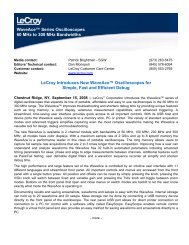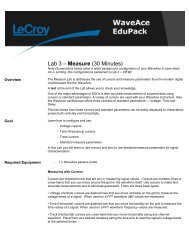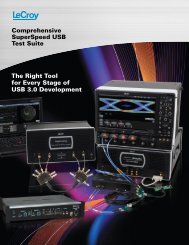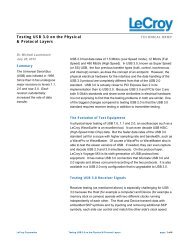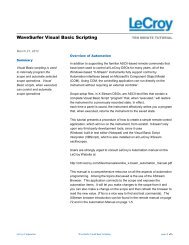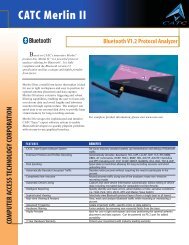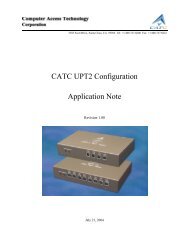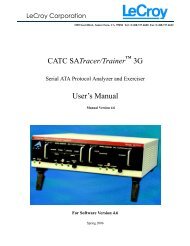Performance Verification Test Record - LeCroy
Performance Verification Test Record - LeCroy
Performance Verification Test Record - LeCroy
Create successful ePaper yourself
Turn your PDF publications into a flip-book with our unique Google optimized e-Paper software.
LPA-2.92 mm to ProLink Probe Adapter<br />
WaveLink Series Differential Probe (13-25 GHz)<br />
This adapter provides a simple and effective method to convert a WL-2.92MM platform/cable<br />
assembly to the <strong>LeCroy</strong> ProLink interface.<br />
<strong>LeCroy</strong>'s 2.92mm interface utilizes a 2.92mm connector for the signal, and a LEMO connection<br />
for probe power and communication. This interface is used for >=20 GHz inputs on <strong>LeCroy</strong><br />
oscilloscopes.<br />
<strong>LeCroy</strong>'s ProLink interface utilizes a blind-mate adapter (BMA) connector for the signal and 6-pin<br />
connection for probe power and communication.<br />
In order to better leverage the complete probe system amongst all possible input types, the<br />
LPA-2.92 may be used to adapt a WL-2.92MM platform/cable assembly to a ProLink connection<br />
- saving you from having to purchase of an additional type of Platform/Cable Assembly. This<br />
adapter is included standard with the WL-2.92MM platform/cable assembly.<br />
Differential Amplifier Small Tip Module with Solder-In<br />
Interconnect Leads<br />
This module contains the active amplifier circuitry and performs the important task of<br />
amplifying the low-level signal at the probe tip for transmission to the oscilloscope via the<br />
Platform/Cable Assembly.<br />
For this 13-25 GHz probe series, <strong>LeCroy</strong> utilizes advanced differential distributed (traveling<br />
wave) amplifier architecture to achieve superior high frequency broadband performance. A<br />
distributed amplifier uses a transmission line to provide inputs to a series of amplification<br />
stages. Another parallel transmission line is used to sum the outputs of each amplification stage.<br />
The two transmission lines are designed with specific delay and impedance characteristics to<br />
ensure that the amplification stages are summed correctly. Since the amplifier gain stages add<br />
rather than multiply (as in a typical cascade design), it is possible to achieve high gain over a<br />
wide frequency range with very low inherent noise. This provides the added benefit of a lower<br />
probe attenuation, which enables the oscilloscope to be operating in an input range which itself<br />
requires lower gain, and hence will typically have lower noise. In addition, higher bandwidths<br />
can typically be achieved with this amplifier architecture.<br />
WL-HBW-OM-E RevC 12



